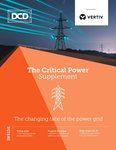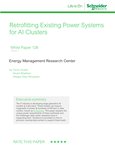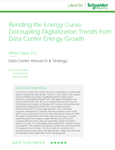In recent years, hydrogen has been increasingly posited as an alternative green energy source for the data center industry, though never one without caveats and hesitation.
While there is much discussion surrounding hydrogen energy, the lack of existing infrastructure – specifically a “grid” or, more accurately, a network of pipelines – along with the short supply of sustainable forms of hydrogen, means that its widespread use as a power source remains in the realm of the hypothetical.
But other solutions – such as hydrogen fuel cells – are increasingly being tested and deployed at data centers, both as a primary power source, and for backup power.
A small but successful deployment
Yuval Bachar is the founder and CEO of EdgeCloudLink (ECL), a data center provider that has based its entire philosophy around hydrogen power. With a 1MW data center in the US already operating on 100 percent hydrogen power and another 1GW campus planned, the company is betting big on the element.
Despite this, Bachar does not underestimate the scale of the problem of switching to green energy solutions.
The data center industry is “struggling with actually finding a significant leap in the generation of energy technology that is clean,” Bachar says. He explains: “Solar is doing its work, but solar works for six hours a day, so there are another 18 hours that we need to do something about. And wind is either there or not.” He posits that hydrogen could bridge that gap.
ECL’s Mountain View, California, data center launched in May 2024 and offers 1MW of capacity powered entirely by hydrogen.
The company uses Proton Exchange Membrane (PEM) fuel cells in a configuration of its own design to power the facility.
“A fuel cell is an element that actually takes hydrogen on one side, and oxygen on the other side,” Bachar explains. “It features plates that are capable of getting injected with hydrogen on one side and oxygen on the other. Because of the effect of the combination of hydrogen and oxygen, the plate is creating a small voltage, about 0.627 volts of DC power. You put a lot of them together and ramp it up.”
Bachar makes this process sound simple, but the cells are complex creations. In addition to producing power, they also create water through the combination of hydrogen and oxygen. “You can actually use that water,” adds Bachar, “We roll it back into the data center, and that’s how we achieve a zero water site as we are using water we have produced.”
The hydrogen used to power the data center is literally shipped to Mountain View in tanks, with a delivery every two weeks. This is the only way the company can get the fuel it needs because infrastructure enabling the widespread delivery of hydrogen is, well, close to non-existent.
“This is a business that we kind of had to go and reinvent because companies that sell hydrogen are not related to the data center world,” Bachar says. “These are companies that are doing what is called material handling. They are selling gases and liquids to labs, petrochemical factories, and refineries.
“We came to them and said: ‘We have an adjacent market to what you are doing and will start consuming lots of hydrogen. Show us how you can deliver it.’ And they came back with two options. One is a network of pipelines that can distribute gas hydrogen, and then we attach ourselves to that pipeline. The other is that they deliver liquid hydrogen.”
Delivering liquid hydrogen isn’t a particularly scalable option for the multi-gigawatt campuses being developed around the world. For larger campuses, including ECL’s planned 1GW site, a network of pipes would be necessary.
On the other side of the US, Active Infrastructure is developing a 3.5 million sq ft (325,160 sqm) data center campus that it claims will be powered by hydrogen.
Jeff Zygler, founder and CEO of Active Infrastructure, explains to DCD that the company will be using hydrogen fuel cells for base load power, but eventually will also use hydrogen for backup power. The company is using solid oxide fuel cells from Bloom Energy, which have a nameplate power output of 300kW and a load output of 300kW.
The data center project is being developed on land with a natural gas pipeline already in place, and Active Infrastructure is working with Bloom Energy to use that natural gas to create hydrogen power.
“The group we are working with takes natural gas, puts it through their equipment, which converts it to hydrogen, and then generates power while releasing water vapor and carbon dioxide, eliminating the additional emissions [NOx and SOx, otherwise associated with burning natural gas],” says Zygler.
Active Infrastructure has the electricity infrastructure available for up to 900MW, but is currently designing for a 780MW campus, all of which will be behind the meter.
This was a big part of the pitch for the project, with Zygler explaining that it means they are not “offsetting or offloading onto the grid.”
“One of the proposals we sent to the supervisors, and we are currently talking to power companies, is that these are quiet generational assets and don’t have a lot of visual disturbance – for example, a smokestack, or massive chimneys,” he adds. “We could actually contribute our generation to the grid.”
The hydrogen rainbow
The use of natural gas converted to hydrogen by Active Infrastructure would be considered “gray hydrogen.”
Hydrogen is rated on a color scale, with the most prominent being gray, which is generated through the steam reforming of natural gas and has high greenhouse gas emissions associated with it. Blue hydrogen is similar to gray, but with carbon capture and storage at the site of production, while green is produced using renewable energy such as solar or wind, thus generating minimal emissions. There is also white hydrogen, which is naturally occurring, and which is hoped will one day play a role in the hydrogen economy, though it is not yet utilized.
Zygler says green hydrogen “is a unicorn right now.” He explains: “It doesn’t really exist because, at least in the US, the infrastructure to generate it using renewable energy isn’t happening in the market on a size and scale that is usable.
“There’s a provider down south generating green hydrogen, but there isn’t a massive demand for it right now. In essence, you could take that renewable energy and put it directly into the grid, and it will be more efficient than using it to convert into hydrogen.”
The battle of gray, blue, and green is also being tackled by ECL’s Bachar.
While up and running – and with prominent customers such as AI cloud provider Lambda – ECL does not pretend to have succeeded in using fully “green” or “blue” hydrogen yet.
“We are buying a blend of gray, blue, and green, but trying to maximize the blue and green, and minimize the gray,” Bachar says. “We are aiming, by 2026, to completely eliminate the gray, and from there, we will push to increase the percentage of green.
“Blue hydrogen itself is going through an evolution. The level of carbon capture has been at a certain level, but the message we need to send is that carbon capture needs to get better and lower the carbon footprint further so that blue hydrogen can get very close to green in the next couple of years. It’s much easier to obtain than green hydrogen, of which there isn’t very much available,” Bachar says.
Hydrogen itself isn’t actually a sparse commodity.
According to the International Energy Agency, around 70 million tonnes of hydrogen are made each year, though most of this goes to industrial processes such as the manufacturing of ammonia for agricultural fertilizers, and the vast majority of this hydrogen is not renewable.
Currently, around 95 percent of hydrogen is generated via fossil fuels.
So, there is a lot of hydrogen produced, it just isn’t the right kind of hydrogen, and it isn’t targeting the data center industry, although several government and international initiatives are currently underway, aiming to increase the amount of green and blue hydrogen available and thus make it a more affordable option.
A November 2024 Uptime Institute report noted that the US government aims to be able to offer green hydrogen for $1 per kg by 2031 – though with a new administration in charge pushing energy of all kinds, including fossil fuels, the future of this commitment remains uncertain – while EU projections are predicting €3 ($3.15) per kg by 2030. However, the International Council on Clean Transportation suggests these are unrealistic and instead offers a US price of $3-5 per kg in 2030 and a European price of €4-€8 ($4.20-8.40) per kg.
On the production side, the EU is planning to produce 10 million tonnes of renewable hydrogen and import a further 10 million tonnes by 2030, while the UK is aiming to create 10GW of low-carbon hydrogen production capacity by 2030.
Research from BloombergNEF in 2024, however, found that governments were likely to miss their aggregate hydrogen demand goals for 2030 by almost two-thirds due to “longer project completion timelines and insufficient policy support.”
Hydrogen as a backup power solution
Hydrogen could logically play as a backup power source, where it would be required in lower quantities. Instead of using diesel generators, companies could explore green and blue hydrogen as a fuel.
This is ultimately the intention for Active Infrastructure.
“Once we get up to scale, we will transition the hydrogen fuel cells from base load to some form of backup power,” says Zygler. “But hydrogen fuel cells [solid oxide] are only cost-efficient if they are running at 100 percent. Once the grid is expanded to allow us to connect, the best-case scenario would be that we are still running those fuel cells at 100 percent and putting it back into the grid, but then if the grid fails, we are still directly connected to the fuel cells and they can provide that uninterrupted power.”
ECL, on the other hand, uses batteries for backup if necessary but has built-in redundancy in the IP of its hydrogen fuel cells.
“We created what we call power generation units, and they deliver the high availability, high reliability power,” explains Bacher. “The reason for that is we have two of them in every block, and in each block we have an N+6, so we can lose up to six fuel cells in every element and still maintain 100 percent power.” ECL’s power blocks offer between 1-2MW, and are a modular design, enabling easy expansion.
Several companies have tested the use of Hydrogen for backup power – including the likes of Equinix, Microsoft, and automaker Honda. But, according to Uptime Institute, only one company is “actively” using hydrogen for standby power – NorthC.
In Europe, NorthC is using hydrogen for backup power at two data centers in the Netherlands.
The company installed PEM fuel cells – generally considered the best of the hydrogen fuel cell options for backup power – at its Groningen data center in 2022, which use locally generated green hydrogen from the NortH2 hydrogen hub to power them. At its Eindhoven data center, the company uses gas engines.
With 3.5MW of capacity, the Groningen data center has enough fuel cells to maintain operations with hydrogen power for a four-hour utility outage, which, according to the operator, is sufficient with the reliability of the electricity grid in the country. Should this not suffice, a diesel fuel tank is on standby to pick up the slack.
Fuel cells are not immaculate in the role of backup power, however. As noted by Zygler, solid oxide fuel cells need to operate at 100 percent to be as efficient as possible, and PEM fuel cells take a while to power up – around seven minutes – compared to the one-minute ramp-up of a diesel genset.
With data center operators’ primary concern being getting as close to that “100 percent uptime” rating as possible, seven minutes of complete downtime, and the potential damage that could be done to hardware as a result, is not ideal. To get around this, NorthC has upped its battery deployment at the campus to buffer the interim.
Uptime Institute’s analysis of the data center solution notes that the fuel cells as a backup solution are “unlikely to be economically justified” on their own. NorthC eventually plans to use hydrogen as its primary power source – taking almost entirely the opposite approach to Active Infrastructure.
The data center will continue to rely on NortH2, which generates hydrogen from its offshore wind farm. By 2030, the plant aims to produce 4GW of hydrogen power, and 10GW by 2040, while a pipe network should reach Groningen between 2026 and 2028.
At the Eindhoven facility, NorthC has fitted hydrogen-burning Innion Jenbacher gas engines, as the region is not expected to connect to a hydrogen pipeline any time soon. Those engines can run on both natural gas and hydrogen.
Optimism for the future
Despite NorthC being the only company currently embracing hydrogen for backup power, in 2024, Plug Power – a provider of PEM fuel cells – said that it is anticipating sales of its offerings to the data center sector to pick up in late 2025, with the company already engaged and doing initial deployments and tests with the “three major data center operators.”
There is further possibility for hydrogen with a “peak dropping” implementation. Andrew Clough, senior electrical engineer at Arup, tells DCD that with challenges around getting utility supply for any sort of data center on a sensible timeline, we might see data centers with “a utility supply that does most of the day but maybe doesn’t have capacity for peak time, and then you could have hydrogen being used on site for peak dropping.”
Over in the US, Bloom Energy signed a deal with American Electric Power (AEP) towards the end of last year that would see Bloom providing up to 1GW of solid oxide fuel cells, which AEP will colocate at AI data centers to support power needs. Though the fuel cells will initially be natural gas powered, they can be run on hydrogen or a blend of the two.
Jeff Barber, Bloom Energy’s VP of global data center sales, told DCD earlier this year that the company’s microgrid solution can supplement the grid, “providing 80MW while the utility supplies 20MW,” or can completely replace the utility grid if necessary.
However, Clough notes that the use of hydrogen is limited by location. Speaking specifically of the UK – though applicable to any Tier 1 market today – London in particular has not just power constraints but space constraints. With current options for hydrogen power – both primary and backup – requiring onsite storage, this gets “tricky.”
Clough says: “Traditionally, data center operators have wanted 24 or 48 hours of diesel stored on site, which is relatively achievable. You get some bigger tanks, but diesel is relatively energy-dense. Hydrogen, on the other hand, is tricky because 48 hours of storage is a substantial amount of hydrogen for a large data center deployment.” Clough estimates that “an hour or two” of grid instabilities is a more feasible scale.
He suggests that as projects move out of these densely populated areas – citing those being proposed for Northumberland or Scotland as an example – hydrogen deployments could make sense. Even more ideally, if your data center is located “in an area close to hydrogen infrastructure, suddenly you could have a situation where you have an electricity supply and a pipe charging supply.”
As demand from the data center industry grows – both for primary power and backup power – the hope can only be that the production of blue and green hydrogen will grow with it. That decision remains entirely within the hands of those purchasing energy or fuel for their data center.
ECL’s Bachar notes that the data centers we develop today are going to stay with us “for at least 15 to 20 years.”
“Even though right now we [the industry] are in a rush to build data centers for AI, we need to make sure we are making the right choice now. We can’t be restarting coal plants. What we do now will stay with us for the next couple of decades.”
Read the orginal article: https://www.datacenterdynamics.com/en/analysis/a-green-revolution-hydrogen-fuel-cells-in-the-data-center/











